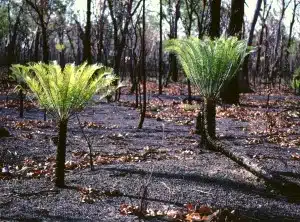Soil has the answer to burning climate questions
Decreasing the frequency of wild fires in northern Australia would lead to an increase in the amount of carbon stored in the soil, significantly lowering greenhouse gas emissions, according to CSIRO ecologist, Dr Anna Richards.
Fire is part of the natural cycle of northern Australia’s savannas. But what’s the best regime? Anna’s studies show that reducing fire frequencies results in greater carbon capture. Up to four times more greenhouse gases are stored underground. And that means they are not going up in smoke.
There are more fires each year in the northern third of the country than anywhere else in Australia. These fires account for about 3 per cent of the nation’s greenhouse gas emissions.
While fire is important for maintaining a healthy environment in northern Australia, Anna says, scientists have become concerned at the increase in frequency and intensity of wild fires over the past century. “About half the Top End is burnt each year and this is changing the environment as well as releasing large quantities of greenhouse gases into the atmosphere.”
Until now, it was assumed that it was really only the amount of smoke that contributed to these emissions, but Anna has shown that things are much more complicated than that. There is an interaction with the soil as well.
“The frequency of fires affects the chemistry of the soil and the workings of the plant roots—hence the capacity of the soil to store carbon, “she says. “In general, the greater the frequency of fires, the more carbon is released from the soil, and vice versa.”
Using measurements of soil carbon from long-term fire experiments conducted near Darwin and sophisticated computer modelling, Anna found that reducing fire frequency to one fire every four to six years is best for storing carbon. Her work was published recently in the international journal Ecosystems.

As part of the Tiwi Carbon Study with the Tiwi Land Council, Anna Richards works with Indigenous rangers to collect carbon data”. She is pictured here with Tiwi Land Ranger Kim Brooks (photo: Barbara McKaige)
“Until now, scientists have known little about the impact of different fire management options on the amount of carbon stored in soil. These findings are significant for managing carbon in northern Australia, particularly for programs that use indigenous fire management practices to reduce fire frequency and severity,” she said.
Anna is conducting further research on the effects of fire on soil carbon as part of the Tiwi Carbon Study in the Tiwi Islands, north of Darwin. The Tiwi Carbon Study is a partnership between CSIRO, the Tiwi Land Council, the Tiwi College and Tiwi Forests.
Anna Richards is one of 16 winners of Fresh Science, a national competition for early-career scientists who are unveiling their research to the public for the first time. Her training and challenges have included presenting her discoveries in verse at a Melbourne pub, and to schools in Melbourne and country Victoria.
For interviews, contact Anna Richards on Anna.Richards@csiro.au
For the CSIRO, contact Barbara McKaige on Barbara.McKaige@csiro.au
For Fresh Science, contact Sarah Brooker on 0413 332 489 or Niall Byrne on 0417 131 977 or niall@scienceinpublic.com.au








 Fresh Science is on hold for 2022. We will be back in 2023.
Fresh Science is on hold for 2022. We will be back in 2023.